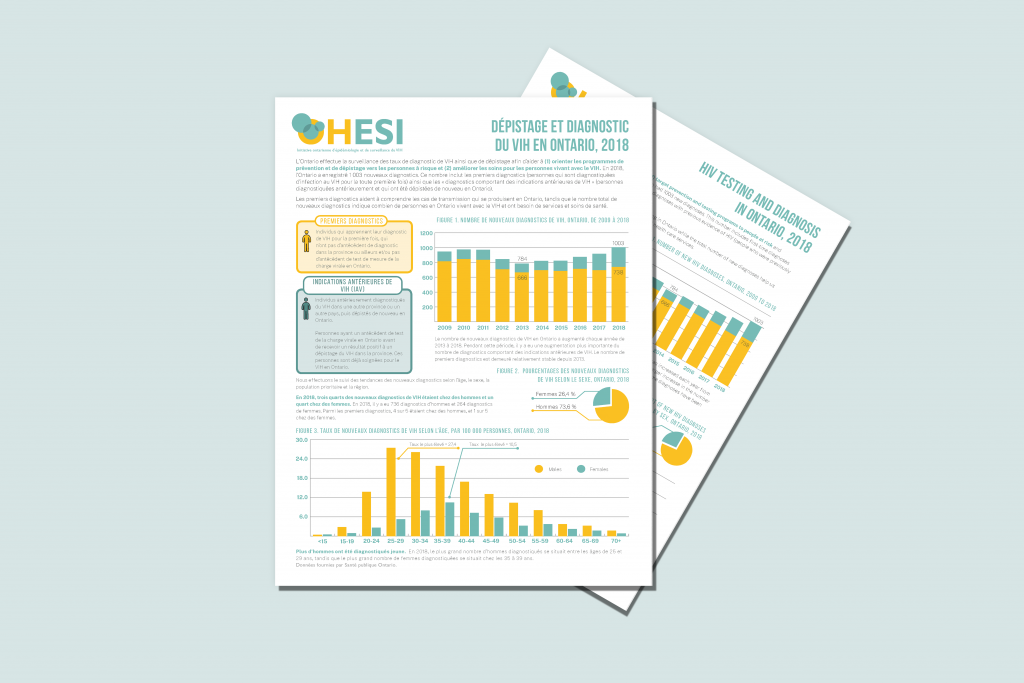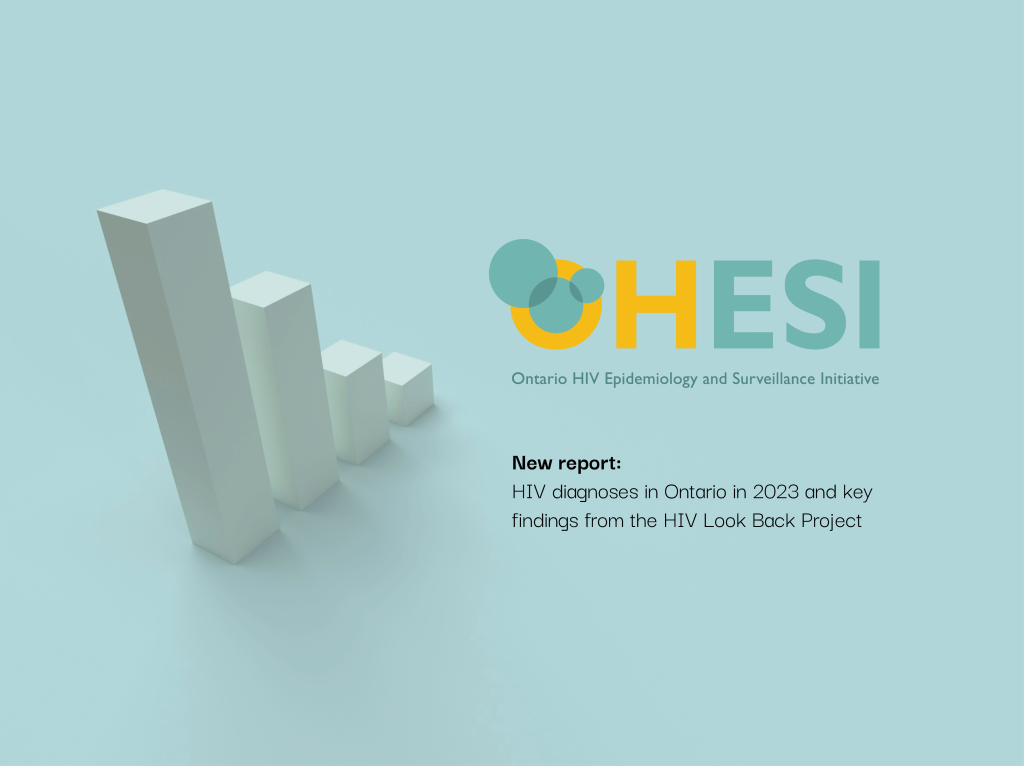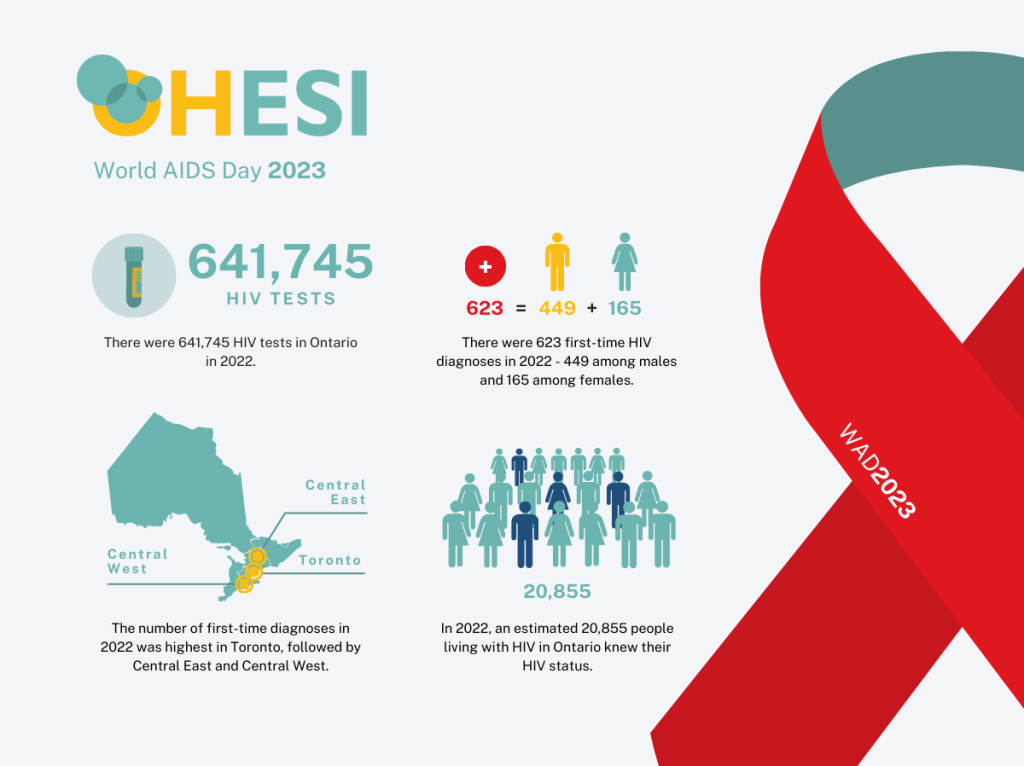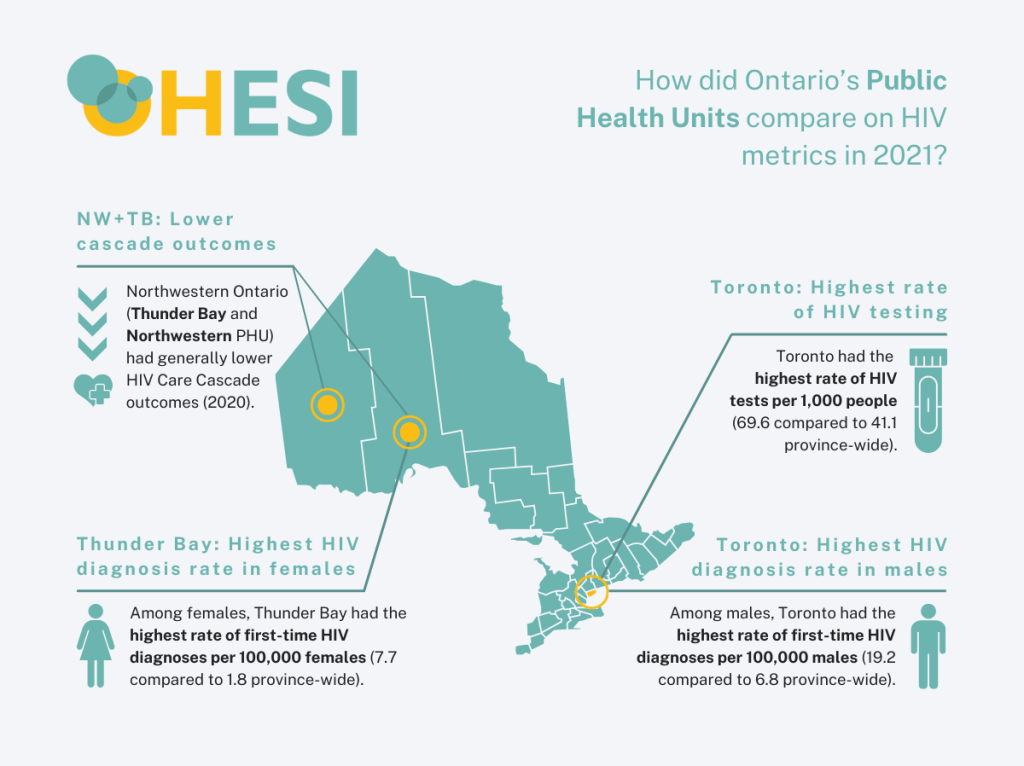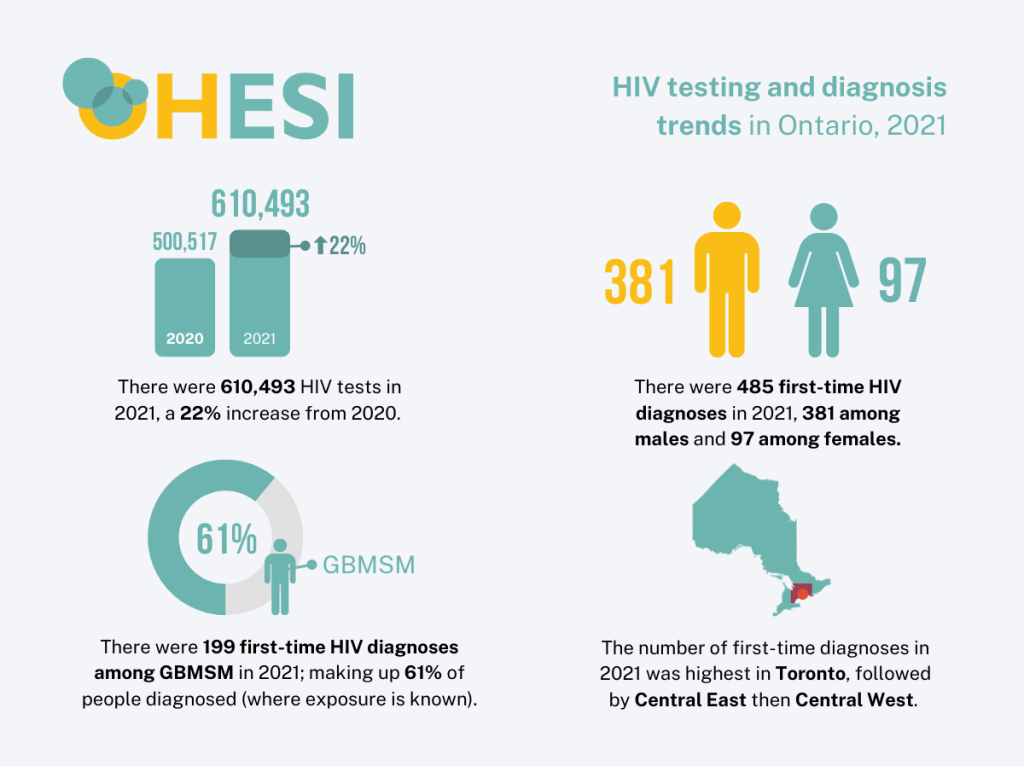Dec 16th, 2019
HIV diagnoses in Ontario: Refinements to surveillance data in the 2018 reports
Summary
- OHESI continues to refine and update the methods we use to improve our understanding of HIV transmission in Ontario.
- Reporting on new HIV diagnoses in Ontario is important to 1) understand local transmission in Ontario and 2) best inform policy and planning services that can be tailored to all people living with HIV.
- In an effort to better understand trends in HIV diagnoses, we report two diagnosis definitions:
- “New HIV diagnoses” consist of all new diagnoses including 1) first-time diagnoses as well as 2) people with previous evidence of HIV – that is, people who already knew their status at the time of their first positive nominal diagnostic test in Ontario
- “First-time diagnoses” removes people with previous evidence of HIV, including a documented previous HIV diagnosis outside of Ontario and/or viral load test history within Ontario.
- People who know their HIV-positive status may be retested later on and not all of these repeated tests can be linked to their prior test results. A test cannot be linked to previous result when:
- Their first positive test was done outside Ontario.
- Their first positive test in Ontario was coded or anonymous.
- o They have changed their name or OHIP number.
- In 2018, there were 1,003 new HIV diagnoses in Ontario. As a result of removing diagnoses with previous evidence of HIV, there were 738 first-time HIV diagnoses in 2018.
What’s new in the 2018 HIV diagnosis surveillance data?
A more accurate picture of people diagnosed or entering care for HIV in Ontario and people who are learning their HIV diagnosis for the first time.
New HIV diagnoses in Ontario
We report on new HIV diagnoses in Ontario to inform policy and planning services that can be tailored to all people living with HIV. New HIV diagnoses include all HIV-positive diagnoses in Ontario. A new HIV diagnosis is not the same as a new infection. Most people living with HIV are not diagnosed in the same year they became infected with the virus.
The new HIV diagnosis definition includes 1) first-time diagnoses and 2) people who have previous evidence of HIV. Individuals with previous evidence of HIV either 1) had an HIV-positive diagnosis outside of Ontario and later retested in Ontario (as recorded on the test history section of the laboratory enhancement program (LEP) case report form or the test requisition form), or 2) had a history of viral load testing in Ontario (without a recorded and linked prior confirmatory diagnostic test in Ontario).
Recent trends in new HIV diagnoses could be due to changes in testing programs, local HIV transmission and/or migration.
First-time HIV diagnoses in Ontario
First-time diagnoses are new HIV diagnoses with no previous evidence of HIV. We look at this number to better understand which diagnoses are likely due to local transmission in Ontario and, therefore, what populations might be at most risk and benefit most from prevention activities. We report on first-time diagnoses separately to better understand local transmission.
First-time diagnoses exclude anyone with a previous positive diagnostic test as indicated on the LEP form, regardless of the location of the previous positive test (inside or outside of Ontario). It also uses linked viral load testing history in Ontario as evidence of being in care for HIV and so excludes 1) anyone with a history of viral load testing in Ontario of more than 30 days before a first diagnostic positive test and 2) anyone with viral load testing in Ontario within 30 days (including same day) with a viral load <200 copies/mL.

Both the new HIV diagnoses and first-time HIV diagnoses definitions include individuals who reside in another province but test HIV-positive in Ontario. Both definitions exclude duplicates – that is, a diagnosis with a documented history of a previous HIV diagnosis within Ontario. Duplicates can be recognized by lab records or the test history section of the LEP/HIV test requisition form indicating a previous positive in Ontario.
Why do some new diagnoses have previous evidence of HIV (PEH)?
HIV diagnoses with previous evidence of HIV include both 1) people who may be new to the province who already knew their HIV-positive status and have a confirmatory HIV test in Ontario and 2) people who may have been infected in Ontario and have been living and receiving care in the province but have no prior linked confirmatory diagnostic test in Ontario. Excluding these individuals better reflects who is testing to learn their status and, therefore, which people might be at greater risk of HIV transmission in Ontario today.
People move to Ontario
People who move to Ontario from another province or country and already know their HIV-positive status can be retested when they arrive in the province. Some reasons for retesting could include immigration, insurance, entering care. This information is most often captured in their testing history when they retest in Ontario. These individuals were initially diagnosed (and likely infected) outside of Ontario. We refer to these new diagnoses as ‘out-of-province’ and they are counted as new diagnoses with PEH.
People have previous viral load testing history in Ontario
Some people have a linked history of viral load testing in Ontario before having a positive nominal diagnostic test in Ontario. These people already received care for HIV in Ontario. Possible reasons a person may not have a linked diagnostic test prior to having viral load testing include (but are not limited to):
- A diagnostic test was ordered for someone who had been in care and knew they were living with HIV (e.g., by a new clinic or new clinician)
- Their first diagnostic test in Ontario was done as an anonymous or coded test (and therefore unlinked) or for some other reason it was not possible to link their historical diagnostic test with their viral load results.
- They had a nominal diagnostic test but had a name or OHIP number change, so their first diagnostic and viral load tests couldn’t be linked.
- They were diagnosed outside of Ontario and a diagnostic test was not ordered when they initially entered care in Ontario.
- A viral load test was ordered for someone who did not know their HIV status and subsequently had a diagnostic test.
What are the trends in new HIV diagnoses and first-time HIV diagnoses in Ontario?
The number of new diagnoses and the number of first-time HIV diagnoses in Ontario between 2009 and 2018 are shown in the figure below.

Figure 1. The number of new HIV diagnoses and first-time HIV diagnoses, Ontario, 2009 to 2018
There were 1,003 new HIV diagnoses in Ontario in 2018. After excluding diagnoses with previous evidence of HIV, there were 738 first-time HIV diagnoses in Ontario in 2018. The number of new HIV diagnoses in Ontario was lowest in 2013 and has increased each year from 2013 to 2018. Over that time period, there was a larger increase in the number of diagnoses with previous evidence of HIV. First-time diagnoses have been relatively stable since 2013.
Considerations about our definitions and surveillance data
- Excluding previous positive diagnoses in Ontario (duplicates) is only possible when previous HIV-positive tests can be linked. Reasons for unlinked data include an individual having one (or more) anonymous or coded HIV tests prior to their nominal test. Another reason could be because the ‘testing history’ section on the LEP form is either missing or not filled out correctly. Approximately 50% of new diagnoses have both the LEP forms returned and the test history section complete.
- When an individual has a history of viral load testing, they may have already received a diagnostic test in Ontario that could not be linked to their viral load tests. That first diagnostic test could have been anonymous, coded, or unable to be linked for some other reason. When this person is included because they’ve received a new diagnostic test, they may be counted twice in the data, at the time of their first diagnosis and their new diagnostic test. These individuals are counted as a new diagnosis but removed as a first-time diagnosis.
What is surveillance data and what does it tell us?
- Public health surveillance collects, analyzes, and disseminates health-related data to help monitor, provide information to, and improve the health of populations.
- Information from surveillance data can be used to monitor the burden of a disease and detect changes over time (trends and outbreaks), and help inform and guide prevention and intervention programs.
- Surveillance data can give insight into which populations are at risk for HIV, including demographic information, risk factors, and clinical factors of people newly diagnosed.
- The Ontario HIV Epidemiology and Surveillance Initiative (OHESI), a collaboration between Public Health Ontario, the Ontario HIV Treatment Network, the Ontario Ministry of Health and Public Health Agency of Canada, is dedicated to providing the most accurate HIV surveillance data for Ontario.
- By refining the HIV diagnosis definition, OHESI aims to report the best estimate of the actual number of first-time HIV-positive diagnoses in Ontario, as well as improve our interpretation of local transmission and trends over time.
Getting an HIV test in Ontario
- Data on new HIV diagnoses come from the laboratory at Public Health Ontario (PHO), which conducts all HIV diagnostic testing requested by health care providers in Ontario.
- When someone gets an HIV test in Ontario, the health care provider ordering the test (e.g. a physician or HIV counsellor) fills out a form that is sent to PHO. This form, known as an HIV test requisition, collects information on the individual being tested, including their sex, age and HIV risk factors. As of 2018, the HIV test requisition form also collects data on race/ethnicity, country of birth, transgender identity and expands answer options in the ‘reason for testing’ and ‘previous test information’ sections.
- If the result of the HIV test is positive, the Laboratory Enhancement Program (LEP) sends a second form to the provider who ordered the test to collect more information or information that may have been missed on the first form. Since 2009, the LEP form has collected information on race/ethnicity, country of birth, and test history (data not historically collected on the HIV test requisition).
- The test history question on the LEP form asks if the individual who tested HIV-positive had ever had a previous positive HIV test and, if so, if this previous positive test was performed in Ontario or out of province.
- Information reported on the HIV test requisition and the LEP form is used to refine the new HIV diagnoses definitions.
Factsheet
HIV testing and diagnosis in Ontario, 2018
In this factsheet, OHESI reports on the trends of HIV testing and diagnoses in Ontario over the past decade, with an emphasis on new diagnoses in 2018.

